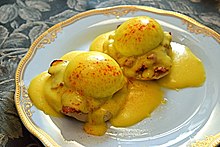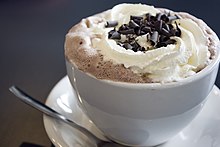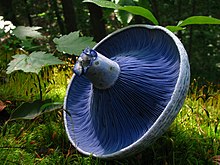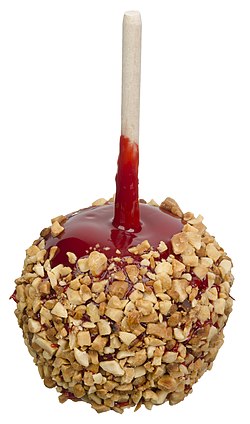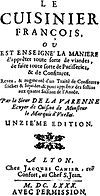Portal:Food
F o o d
A portal dedicated to food and foodways
Introduction


Food is any substance consumed by an organism for nutritional support. Food is usually of plant, animal, or fungal origin and contains essential nutrients such as carbohydrates, fats, proteins, vitamins, or minerals. The substance is ingested by an organism and assimilated by the organism's cells to provide energy, maintain life, or stimulate growth. Different species of animals have different feeding behaviours that satisfy the needs of their metabolisms and have evolved to fill a specific ecological niche within specific geographical contexts.
Omnivorous humans are highly adaptable and have adapted to obtain food in many different ecosystems. Humans generally use cooking to prepare food for consumption. The majority of the food energy required is supplied by the industrial food industry, which produces food through intensive agriculture and distributes it through complex food processing and food distribution systems. This system of conventional agriculture relies heavily on fossil fuels, which means that the food and agricultural systems are one of the major contributors to climate change, accounting for as much as 37% of total greenhouse gas emissions. (Full article...)
Cooking, also known as cookery or professionally as the culinary arts, is the art, science and craft of using heat to make food more palatable, digestible, nutritious, or safe. Cooking techniques and ingredients vary widely, from grilling food over an open fire, to using electric stoves, to baking in various types of ovens, reflecting local conditions. Cooking is an aspect of all human societies and a cultural universal.
Preparing food with heat or fire is an activity unique to humans. Archeological evidence of cooking fires from at least 300,000 years ago exists, but some estimate that humans started cooking up to 2 million years ago.
The expansion of agriculture, commerce, trade, and transportation between civilizations in different regions offered cooks many new ingredients. New inventions and technologies, such as the invention of pottery for holding and boiling of water, expanded cooking techniques. Some modern cooks apply advanced scientific techniques to food preparation to further enhance the flavor of the dish served. (Full article...)
The Whopper is the signature hamburger and an associated product line sold by the international fast food restaurant chain Burger King and its Australian franchise Hungry Jack's. Introduced in 1957, the hamburger has undergone several reformulations, including changes to portion size and bread used. The hamburger is well known in the fast food industry, with Burger King advertising itself as "the Home of the Whopper" and naming its kiosk stores the BK Whopper Bar. In response to the Whopper, Burger King's competitors have developed similar products designed to compete against it.
Burger King sells several variants that are either seasonal or tailored to local tastes or customs. To promote the product, the restaurant occasionally releases limited-time variants. It is often at the center of advertising promotions, product tie-ins, and corporate practical jokes and hoaxes. (Full article...)
Selected article –
Hollandaise sauce (/hɒlənˈdeɪz/ or /ˈhɒləndeɪz/; French: [ɔlɑ̃dɛz], from French sauce hollandaise meaning “Dutch sauce”)
is a mixture of egg yolk, melted butter, and lemon juice (or a white wine or vinegar reduction). It is usually seasoned with salt, and either white pepper or cayenne pepper.It is well known as a key ingredient of eggs Benedict, and is often served on vegetables such as steamed asparagus. (Full article...)
Selected cuisine -

Soul food is the ethnic cuisine of African Americans. It originated in the American South from the cuisines of enslaved Africans trafficked to the North American colonies through the Atlantic slave trade during the Antebellum period and is closely associated (but not to be confused with) the cuisine of the American South. The expression "soul food" originated in the mid-1960s when "soul" was a common word used to describe African-American culture. Soul food uses cooking techniques and ingredients from West African, Central African, Western European, and Indigenous cuisine of the Americas.
The cuisine was initially denigrated as low quality and belittled because of its origin. It was seen as low-class food, and African Americans in the North looked down on their Black Southern compatriots who preferred soul food (see the Great Migration). The concept evolved from describing the food of slaves in the South, to being taken up as a primary source of pride in the African American community even in the North, such as in New York City, Chicago and Detroit. (Full article...)Selected ingredient –
Whipped cream, also known as Chantilly cream or crème Chantilly (French: [kʁɛm ʃɑ̃tiji]), is high-fat dairy cream that has been aerated by whisking until it becomes light, fluffy, and capable of holding its shape. This process incorporates air into the cream, creating a semi-solid colloid. It is commonly sweetened with white sugar and sometimes flavored with vanilla. Whipped cream is often served on desserts and hot beverages, and used as an ingredient in desserts. (Full article...)
Selected recipe –
The ratio of ingredients and mixing method determines the texture of the crust. If the flour is not well mixed with the shortening, then water can bind to the available flour causing the gluten protein matrix to become over developed. This would result in a tough crust, as opposed to a flaky crust, which is more desirable. (Full article...)
Lactarius indigo, commonly known as the indigo milk cap, indigo milky, indigo lactarius, blue lactarius, or blue milk mushroom, is a species of agaric fungus in the family Russulaceae.
The fruit body color ranges from dark blue in fresh specimens to pale blue-gray in older ones. The milk, or latex, that oozes when the mushroom tissue is cut or broken (a feature common to all members of the genus Lactarius) is also indigo blue, but slowly turns green upon exposure to air. The cap has a diameter of 5–15 cm (2–6 in), and the stem is 2–8 cm (3⁄4–3+1⁄8 in) tall and 1–2.5 cm (3⁄8–1 in) thick. (Full article...)Selected image –
Selected biography –
B. 1618 – d. 1678
François Pierre de la Varenne (French pronunciation: [fʁɑ̃swa pjɛʁ də la vaʁɛn], 1615–1678 in Dijon), Burgundian by birth, was the author of Le Cuisinier françois (1651), one of the most influential cookbooks in early modern French cuisine. La Varenne broke with the traditions that had revolutionised medieval and Renaissance French cookery in the 16th century and early 17th century. (Full article...)
Did you know (auto-generated) –

- ... that strawberry pie is one of the "red foods" traditionally served at Juneteenth celebrations?
- ... that the Cantonese cooking channel Made With Lau began generating about US$50,000 per month in YouTube advertising revenue in under a year?
- ... that the Unitized Group Ration – Express is designed to heat food itself without the need of a field kitchen?
- ... that by 1967, staff at the Home Office were told not to feed Peta morsels of food as she had become "inordinately fat"?
- ... that within the Armenian Rite, it takes 40 days and more than 40 flowers, herbs, and spices to create the chrism known as myron?
- ... that food psychology research has found that the COVID-19 pandemic led to both reduced and increased consumption of junk food among different geographical populations and educational backgrounds?
More did you know –
Related portals
Food topics
The following are topics relating to food
Categories
Food list articles
- See also: Lists of foods and Category:Lists of drinks
The following are some Food list articles on Wikipedia:

- American cheeses
- Appellation d'Origine Contrôlée cheeses
- Apple cultivars
- Bacon dishes
- Bacon substitutes
- Basil cultivars
- Breads
- Breakfast beverages
- Breakfast cereals
- Breakfast foods
- British cheeses
- Cakes
- Candies
- Cheeses
- Cheese soups
- Christmas dishes (list)
- Cocktails
- Cookies
- Dishes using coconut milk
- Diets
- Doughnut varieties
- Egg dishes
- Fermented soy products
- Food additives
- Food additives (Codex Alimentarius)
- Foods named after people
- French cheeses
- French dishes
- Fried dough foods
- Fruits
- List of hamburgers
- Herbs and spices
- Hors d'oeuvre
- Indian dishes
- Indian snack foods
- Indonesian dishes
- Italian dishes
- Japanese snacks
- Japanese dishes
- Jewish dishes
- Kebabs
- Korean beverages
- Mango cultivars
- Moroccan dishes
- Pasta
- Pastries
- Philippine snack food
- Pies, tarts and flans
- Poppy seed pastries and dishes
- Potato dishes
- Puddings
- Raw fish dishes
- Rice dishes
- Rolled foods
- Sauces
- Seafood
- Seeds
- Sandwiches
- Snack foods
- Soft drinks by country
- Soul foods and dishes
- Soups
- Stews
- Street foods
- Tapas
- Turkish dishes
- Twice-baked foods
- Vegetable oils
- Vegetables
- Vodkas
Things you can do
Related WikiProjects
| Parent project: WikiProject Food and Drink | |
| Child projects: | Task forces: (All inactive) |
|
|
| Related projects: | |
New articles
Rules | Match log | Results page (for watching) | Last updated: 2024-09-08 19:15 (UTC)
Note: The list display can now be customized by each user. See List display personalization for details.
- Zaharakos Ice Cream Parlor (edit | talk | history | links | watch | logs | tools) by Valereee (talk · contribs · new pages (6)) started on 2024-09-08, score: 10
- Flavor cocoa (edit | talk | history | links | watch | logs | tools) by Rollinginhisgrave (talk · contribs · new pages (9)) started on 2024-09-08, score: 10
- Maximilian Kilman (edit | talk | history | links | watch | logs | tools) by Killarnee (talk · contribs · new pages (11)) started on 2024-09-08, score: 10
- Spiro Spathis (edit | talk | history | links | watch | logs | tools) by A09 (talk · contribs · new pages (2)) started on 2024-09-08, score: 10
- Types of cocoa beans (edit | talk | history | links | watch | logs | tools) by Rollinginhisgrave (talk · contribs · new pages (9)) started on 2024-09-08, score: 30
- Bulk cocoa (edit | talk | history | links | watch | logs | tools) by Rollinginhisgrave (talk · contribs · new pages (9)) started on 2024-09-08, score: 10
- West Virginia Hot Dog Festival (edit | talk | history | links | watch | logs | tools) by Samz73428091 (talk · contribs · new pages (24)) started on 2024-09-08, score: 10
- Legal definitions of chocolate (edit | talk | history | links | watch | logs | tools) by Rollinginhisgrave (talk · contribs · new pages (9)) started on 2024-09-07, score: 10
- King Island Dairy (edit | talk | history | links | watch | logs | tools) by Pidzz (talk · contribs · new pages (11)) started on 2024-09-07, score: 10
- Whole Foods (edit | talk | history | links | watch | logs | tools) by Turnoffthat (talk · contribs · new pages (2)) started on 2024-09-07, score: 10
- Torno Subito (edit | talk | history | links | watch | logs | tools) by Another Believer (talk · contribs · new pages (124)) started on 2024-09-07, score: 10
- Armani Ristorante (edit | talk | history | links | watch | logs | tools) by Another Believer (talk · contribs · new pages (124)) started on 2024-09-07, score: 10
- Trèsind Studio (edit | talk | history | links | watch | logs | tools) by Another Believer (talk · contribs · new pages (124)) started on 2024-09-07, score: 10
- Avatāra (restaurant) (edit | talk | history | links | watch | logs | tools) by Another Believer (talk · contribs · new pages (124)) started on 2024-09-07, score: 10
- Sagetsu by Tetsuya (edit | talk | history | links | watch | logs | tools) by Another Believer (talk · contribs · new pages (124)) started on 2024-09-07, score: 10
- Hōseki (edit | talk | history | links | watch | logs | tools) by Another Believer (talk · contribs · new pages (124)) started on 2024-09-07, score: 10
- Talea by Antonio Guida (edit | talk | history | links | watch | logs | tools) by Another Believer (talk · contribs · new pages (124)) started on 2024-09-07, score: 10
- 99 Sushi Bar (edit | talk | history | links | watch | logs | tools) by Another Believer (talk · contribs · new pages (124)) started on 2024-09-07, score: 10
- Erth (restaurant) (edit | talk | history | links | watch | logs | tools) by Another Believer (talk · contribs · new pages (124)) started on 2024-09-07, score: 10
- Cadbury Favourites (edit | talk | history | links | watch | logs | tools) by Panamitsu (talk · contribs · new pages (7)) started on 2024-09-02, score: 20
- Brewmaster: Beer Brewing Simulator (edit | talk | history | links | watch | logs | tools) by NinjaRobotPirate (talk · contribs · new pages (9)) started on 2024-09-06, score: 10
- Tempering chocolate (edit | talk | history | links | watch | logs | tools) by Rollinginhisgrave (talk · contribs · new pages (9)) started on 2024-09-06, score: 20
- Mason Montgomery (edit | talk | history | links | watch | logs | tools) by Yankees10 (talk · contribs · new pages (23)) started on 2024-09-05, score: 10
- Mikado cake (edit | talk | history | links | watch | logs | tools) by Athoremmes (talk · contribs · new pages (2)) started on 2024-09-05, score: 20
- William McCormick (physician) (edit | talk | history | links | watch | logs | tools) by Ysh.cabana (talk · contribs · new pages (1)) started on 2024-09-05, score: 10
- Ramen Danbo (edit | talk | history | links | watch | logs | tools) by Another Believer (talk · contribs · new pages (124)) started on 2024-09-02, score: 10
- Hans Lüdemann (edit | talk | history | links | watch | logs | tools) by 4meter4 (talk · contribs · new pages (167)) started on 2024-09-05, score: 10
- Shutki shira (edit | talk | history | links | watch | logs | tools) by Jaunpurzada (talk · contribs · new pages (2)) started on 2024-09-05, score: 10
- Chayan Yuese (edit | talk | history | links | watch | logs | tools) by Pieceofmetalwork (talk · contribs · new pages (5)) started on 2024-09-05, score: 10
- Unilever Israel (edit | talk | history | links | watch | logs | tools) by אקסינו (talk · contribs · new pages (10)) started on 2024-09-04, score: 20
- Seth W. Hancock (edit | talk | history | links | watch | logs | tools) by Jnglmpera (talk · contribs · new pages (1)) started on 2024-09-04, score: 10
- Pure Food and Wine (edit | talk | history | links | watch | logs | tools) by Another Believer (talk · contribs · new pages (124)) started on 2024-09-04, score: 10
- Honey deuce (edit | talk | history | links | watch | logs | tools) by Fortunaa (talk · contribs · new pages (1)) started on 2024-09-04, score: 20
- Kristal (drink) (edit | talk | history | links | watch | logs | tools) by אקסינו (talk · contribs · new pages (10)) started on 2024-09-03, score: 20
- Logan Driscoll (edit | talk | history | links | watch | logs | tools) by Muboshgu (talk · contribs · new pages (7)) started on 2024-08-31, score: 10
- The Detective Wore Silk Drawers (edit | talk | history | links | watch | logs | tools) by Lord Cornwallis (talk · contribs · new pages (81)) started on 2024-09-03, score: 10
- Feastogether (edit | talk | history | links | watch | logs | tools) by Cunard (talk · contribs · new pages (6)) started on 2024-09-03, score: 20
- Chili's at 45th and Lamar (edit | talk | history | links | watch | logs | tools) by TerraFrost (talk · contribs · new pages (1)) started on 2024-09-02, score: 10
- Overeem Whisky (edit | talk | history | links | watch | logs | tools) by Abbaskip (talk · contribs · new pages (2)) started on 2024-08-30, score: 20
- The Alley (restaurant) (edit | talk | history | links | watch | logs | tools) by Another Believer (talk · contribs · new pages (124)) started on 2024-09-02, score: 10
- Teaspoon (restaurant) (edit | talk | history | links | watch | logs | tools) by Another Believer (talk · contribs · new pages (124)) started on 2024-09-02, score: 10
- Saemaeul Restaurant (edit | talk | history | links | watch | logs | tools) by Seefooddiet (talk · contribs · new pages (54)) started on 2024-09-02, score: 10
- Contramar (edit | talk | history | links | watch | logs | tools) by Heroeswithmetaphors (talk · contribs · new pages (12)) started on 2024-09-02, score: 20
- Happy Lemon (edit | talk | history | links | watch | logs | tools) by Another Believer (talk · contribs · new pages (124)) started on 2024-09-02, score: 10
- Sharetea (edit | talk | history | links | watch | logs | tools) by Another Believer (talk · contribs · new pages (124)) started on 2024-09-02, score: 10
- Umu (restaurant) (edit | talk | history | links | watch | logs | tools) by Another Believer (talk · contribs · new pages (124)) started on 2024-09-02, score: 10
- Jamavar (restaurant) (edit | talk | history | links | watch | logs | tools) by Another Believer (talk · contribs · new pages (124)) started on 2024-09-02, score: 10
- Dorian (restaurant) (edit | talk | history | links | watch | logs | tools) by Another Believer (talk · contribs · new pages (124)) started on 2024-09-02, score: 10
- Oxbow (restaurant) (edit | talk | history | links | watch | logs | tools) by Another Believer (talk · contribs · new pages (124)) started on 2024-08-31, score: 10
- Cornitos (edit | talk | history | links | watch | logs | tools) by Atulkumar.1990 (talk · contribs · new pages (2)) started on 2024-08-30, score: 40
- Generation Loss (novel) (edit | talk | history | links | watch | logs | tools) by Czar (talk · contribs · new pages (14)) started on 2024-09-01, score: 10
- Jo Jeong-du (edit | talk | history | links | watch | logs | tools) by Fixer88 (talk · contribs · new pages (122)) started on 2024-08-30, score: 10
- Caloglossa beccarii (edit | talk | history | links | watch | logs | tools) by Mbdfar (talk · contribs · new pages (25)) started on 2024-08-29, score: 10
- Fernanda Fuentes Cardenas (edit | talk | history | links | watch | logs | tools) by ProudWatermelon (talk · contribs · new pages (16)) started on 2024-08-27, score: 20
- Agriculture in ants (edit | talk | history | links | watch | logs | tools) by AgisdeSparte (talk · contribs · new pages (5)) started on 2024-08-25, score: 10
- Ostrich meat (edit | talk | history | links | watch | logs | tools) by Angelbmartin (talk · contribs · new pages (3)) started on 2024-08-29, score: 10
- Caloglossa (edit | talk | history | links | watch | logs | tools) by Mbdfar (talk · contribs · new pages (25)) started on 2024-08-29, score: 10
- Fried onion burger (edit | talk | history | links | watch | logs | tools) by Valereee (talk · contribs · new pages (6)) started on 2024-08-29, score: 30
- Esben Lunde Larsen (edit | talk | history | links | watch | logs | tools) by Liq Siq Giq 41q (talk · contribs · new pages (2)) started on 2024-08-29, score: 10
- Seed oil controversy (edit | talk | history | links | watch | logs | tools) by DoubleGrazing (talk · contribs · new pages (31)) started on 2024-08-29, score: 10
- Watermelon milk (edit | talk | history | links | watch | logs | tools) by Heeheemalu (talk · contribs · new pages (2)) started on 2024-08-29, score: 20
- Ultra-Processed People (edit | talk | history | links | watch | logs | tools) by Folkezoft (talk · contribs · new pages (16)) started on 2024-08-28, score: 20
- Forest Side (restaurant) (edit | talk | history | links | watch | logs | tools) by Another Believer (talk · contribs · new pages (124)) started on 2024-08-28, score: 10
- Sitajakhala (edit | talk | history | links | watch | logs | tools) by Saurabhsaha (talk · contribs · new pages (9)) started on 2024-08-23, score: 10
- Dinner Train (Netherlands) (edit | talk | history | links | watch | logs | tools) by Thief-River-Faller (talk · contribs · new pages (40)) started on 2024-08-28, score: 10
- Food Arts (edit | talk | history | links | watch | logs | tools) by Thriley (talk · contribs · new pages (62)) started on 2024-08-28, score: 30
- Le Fournil (edit | talk | history | links | watch | logs | tools) by Another Believer (talk · contribs · new pages (124)) started on 2024-08-28, score: 10
- Sledging ration (edit | talk | history | links | watch | logs | tools) by Mbdfar (talk · contribs · new pages (25)) started on 2024-08-27, score: 10
- Olho de sogra (edit | talk | history | links | watch | logs | tools) by Cathodography (talk · contribs · new pages (1)) started on 2024-08-26, score: 50
- Uncovered liquids (edit | talk | history | links | watch | logs | tools) by TheRabbi613 (talk · contribs · new pages (3)) started on 2024-08-26, score: 10
- Proud Mary Coffee (edit | talk | history | links | watch | logs | tools) by Another Believer (talk · contribs · new pages (124)) started on 2024-08-26, score: 10
- Uncovered Liquids (edit | talk | history | links | watch | logs | tools) by TheRabbi613 (talk · contribs · new pages (3)) started on 2024-08-26, score: 10
- Saphobius brouni (edit | talk | history | links | watch | logs | tools) by AxonsArachnida (talk · contribs · new pages (94)) started on 2024-08-26, score: 10
- Agriculture (ants) (edit | talk | history | links | watch | logs | tools) by AgisdeSparte (talk · contribs · new pages (5)) started on 2024-08-25, score: 10
- Halen Môn (edit | talk | history | links | watch | logs | tools) by Jonathan Deamer (talk · contribs · new pages (15)) started on 2024-08-25, score: 20
- Ecclefechan tart (edit | talk | history | links | watch | logs | tools) by Nealsie (talk · contribs · new pages (1)) started on 2024-08-25, score: 20
- Agriculture (Ants) (edit | talk | history | links | watch | logs | tools) by AgisdeSparte (talk · contribs · new pages (5)) started on 2024-08-25, score: 10
- Cyclocybe erebia (edit | talk | history | links | watch | logs | tools) by Shroomysean (talk · contribs · new pages (2)) started on 2024-08-25, score: 10
- Masak lemak lada api (edit | talk | history | links | watch | logs | tools) by AyyanD (talk · contribs · new pages (3)) started on 2024-08-25, score: 10
Associated Wikimedia
The following Wikimedia Foundation sister projects provide more on this subject:
-
Commons
Free media repository -
Wikibooks
Free textbooks and manuals -
Wikidata
Free knowledge base -
Wikinews
Free-content news -
Wikiquote
Collection of quotations -
Wikisource
Free-content library -
Wikiversity
Free learning tools -
Wiktionary
Dictionary and thesaurus























